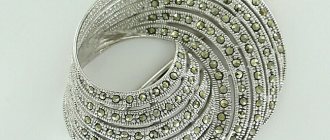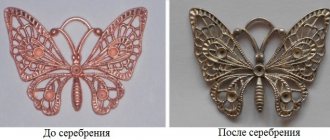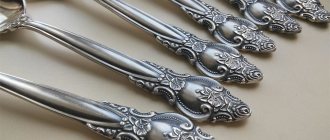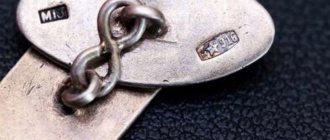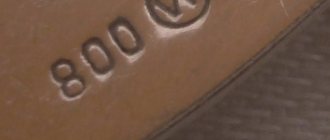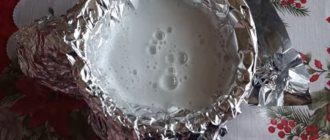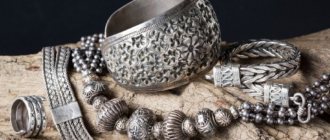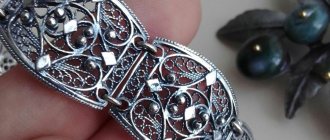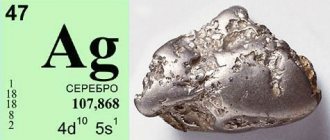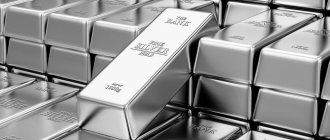Silver nugget
Silver
— Ag, a mineral of the class of native elements, crystallizes in the cubic system, cubic-hexoctahedral type of symmetry. It is found in argenites (sulfide) and horn silver (silver chloride), and is also mined as a by-product of the purification of cuprum and lead. Silver was one of the first metals mastered by man. It is an excellent conductor of heat and electricity. The main producer of silver is Mexico, although silver ores are scattered throughout the world.
- Structure
- Properties
- Reserves and production
- Origin
- Application
- Classification
- Physical properties
- Optical properties
- Crystallographic properties
See also:
Gold
— structure and physical properties
STRUCTURE
Crystal structure of silver
Cubic system; hexaoctahedral c. With. ZL44L636L29RS. Crystal structure. Face centered cube. The appearance of crystals. Properly formed crystals are very rare. Common forms: {100}, {111}. Doubles by (111). Aggregates. It is sometimes found in the form of typical “knitted” feathery dendrites, thin irregular plates and leaflets. Mossy, hair-like and wire-like forms are also characteristic. The most common grains are irregularly shaped and larger continuous clusters called nuggets.
Let it be as bright as the moon
For silver, unfavorable factors are:
- human sweat;
- cosmetic and medicinal preparations containing sulfur, iodine;
- taking vitamin and mineral supplements;
- high temperature (bath, sauna).
All this can harm the color and appearance of the silver item.
Cleaning silver at home is easy. Hold the product in soapy water, rinse, and wipe dry with flannel or suede.
Take your jewelry to a jeweler at least once a year. It will restore the shine and pristine beauty of your favorite trinket using special means.
Good to know: do not try on other people's silver jewelry and do not let them measure your own.
PROPERTIES
Silver bars
The color is silver-white, often with yellow, brown or black tarnish. Silver from the surface oxidizes quite quickly in air and the faster the more impurities it contains, while the color of the surface changes to black with a tint of various shades. The luster is metallic to matte, the color of the streak is silver-white, shiny. Hardness 2.5 -3. Density 9.6 -12. There is no cleavage, the fracture is conchoidal. Very plastic, flexible, malleable. It has the highest thermal and electrical conductivity among metals. Is diamagnetic. Melts easily under a blowpipe. It reacts with HCl to form a white cheesy precipitate (AgCl). Reaction with H2S gives a black color.
Silver magic
The magical properties of the noble metal are recognized even by the church. Epiphany water is blessed with a silver cross; this water is healing. It is good for every baptized person to wear a silver cross.
The magic of silver absorbs negativity directed at the owner of the jewelry. If a precious metal cannot cope with the flow of negative energy (think about who you have annoyed so much), it darkens or even turns black. By the way, this also happens if the owner of the silver jewelry is sick. In any case, it is advisable to visit a doctor and esotericist.
If possible, place a silver figurine, candlestick, or vase in your apartment. This will clear the room of negativity. Don’t forget to inspect the product - it has darkened, changed color - it has accumulated negativity, it’s time to do a “magic cleaning”.
Silver vases
The custom of giving a baby a silver spoon as a gift is useful, researchers of the precious metal have no doubt about it.
Silver spoons
For women, wearing lunar metal bracelets means enhancing their feminine attractiveness. Earrings will help cope with migraines and headaches.
A belt with a silver buckle will help men and women improve their health. Just make sure the buckle is just below your belly button.
RESERVES AND PRODUCTION
Silver on acanthite, 2.3 x 1.8 x 1.1 cm, Peru, Uchucchacua mine
No large deposits are known in the USSR. Silver nuggets were previously found in the Turinsky mines in the Northern Urals, in a number of lead-zinc deposits in Altai, Kazakhstan, Eastern Siberia and other places. Of the foreign deposits, the following deposits were very famous: Kongsberg (Norway), where native silver was found to a depth of 900 m, Cobalt (Canada), Schneeberg (Germany). Mining of silver-containing ores can be done underground or open pit. First, using special instruments, prospectors check underground mines for minerals and precious metals. After discovering areas rich in silver, holes are made in appropriate places into which explosives are placed. The fragments of silver-containing ore raised by the explosion to the surface of the mine are crushed industrially. The precious metal is extracted from ore using the methods of amalgation and cyanidation.
History of discovery
Silver has been known to people for a long time. Historians first noted its significance around the 4th millennium BC. e. Then the first jewelry appeared from this noble metal, which was used as exchange currency.
Over time, people learned the properties of this material and began to use it to purify water from impurities. Shamans and clairvoyants valued this metal, calling it a protector of the soul. Ritual knives and sacred weapons were made from it. Astrologers called this material moonstone. He was supposed to show the way to lost travelers, drive out evil spirits and darkness along the way.
ORIGIN
Silver, width 1 cm, Morocco, Imiter mine
The formation of native silver in nature is in many ways similar to the formation of copper. It, along with other silver-containing minerals, is found in hydrothermal vein deposits in association with argentite (Ag2S) and calcite (Kongsberg deposit in Norway), sometimes in association with complex sulfur, arsenic, antimony compounds of various metals, including nickel and cobalt. Under exogenous conditions, it, like native copper, is found in oxidation zones of deposits of sulfur and arsenic-antimony ores, being a product of their decomposition and reduction from surface solutions by various organic compounds. The native silver formed under these conditions often has the form of dendrites, plates, mossy, wire-like, hair-like forms, etc. It has been experimentally proven that the finest thread-like and dendritic formations, sometimes in the form of beautiful patterns, are formed on pieces of coal from solution, especially in the presence of soluble organic connections. Under surface conditions, native silver is less stable than gold. It is often covered with black films and grease. In areas with a hot, dry climate, it often turns from the surface into stable halogen compounds (AgCl, etc.).
From Macedonski to Sapkowski
In the troops of Alexander the Great, military leaders were sick less often than privates. But both the food and the conditions during the hikes were the same for everyone. The reason for good health (as medical historians suggest) is in the dishes. The rank and file ate from tin plates, while the military leaders were given silver plates.
Our Russian ruble is inextricably linked with silver. No, there is currently no precious metal in ruble and other consumable coins. But the coin got its name from the word “chopping.” In Ancient Rus', silver ingots or rods were in circulation; they were called hryvnias. A piece was cut off from them (corresponding to the price of the product), and it was called a ruble.
Mystical powers have always been attributed to the precious metal. Protection from any evil spirits (even vampires and werewolves, who could only be killed by silver weapons), from the evil eye and other horrors of the night.
Those who have read Sapkowski's books about the witcher Herald (or played computer games based on the book) know: the witcher's sword was made of pure silver metal. After all, the Rivan’s profession was the destruction of all kinds of evil spirits.
APPLICATION
Silver coins
Silver is used mainly in alloys with copper for the manufacture of silver items, coins, etc. Pure silver is used for filigree work, making crucibles for melting alkalis, for silvering, for obtaining chemical compounds and other purposes. The bulk of silver (about 80%) is mined not in native form, but as a by-product from silver-rich lead-zinc, gold and copper deposits. The areas of application of silver are constantly expanding, and its applications include not only alloys, but also chemical compounds. A certain amount of silver is constantly consumed for the production of silver-zinc and silver-cadmium batteries, which have very high energy density and mass energy intensity and are capable of delivering very high currents to the load with low internal resistance.
Silver - Ag
| Molecular weight | 107.87 g/mol |
| origin of name | Anglo-Saxon (Silber, silver, Gothic silubr), with a correspondence in Proto-Slavic (sеrebro) |
| IMA status | valid, first described before 1959 (before IMA) |
Coatings of silver products
Currently, the most technologically advanced types and methods of coating silver products are:
- “White” boiling is boiling in sulfuric or hydrochloric acid to reduce the content of copper reacting with hydrogen sulfide in the thin surface layer of the product. The surface acquires a matte tint.
- Electroplating — applying a thin layer of precious metal using the electroplating method. Currently, electroplating is the most popular way to protect and decorate silver jewelry. Depending on the metal that performs the function of the protective layer, the following types of coatings are used:
- Silvering is a coating with a thin layer of pure silver, which reacts weaker than alloys with hydrogen sulfide in the air.
- Rhodium plating is coating with a layer of white and, less commonly, black or yellow rhodium. Rhodium is a precious platinum group metal. It is wear-resistant, does not darken, and has a beautiful mirror-like light-steel shine, which is why in the last 10–15 years it has become one of the most popular coatings on the jewelry market. If repaired by soldering, the rhodium plating turns black and cracks. In this case, the old coating must be removed and a new one applied.
- Gilding is gold plating. It is actively used for complete or partial decoration of silver products.
- Passivation (passivation) — transfer of the top layer of the alloy into a passive state, which sharply slows down corrosion processes. Performs a purely protective function.
- Oxidation is a type of passivation, the creation on the surface of a metal of a dense film of oxides that protects it from corrosion. It is both a decorative and protective coating method.
- Electrophoresis deposition - coating with organic polyurethane foam or acrylic by immersion in an aqueous solution of epoxy or acrylic resin under the influence of tension. Performs only a protective function.
PHYSICAL PROPERTIES
| Mineral color | silver-white, on the oxidized surface dark gray turning to black |
| Stroke color | silver white |
| Transparency | opaque |
| Shine | metal |
| Cleavage | No |
| Hardness (Mohs scale) | 2,5-3 |
| Strength | malleable, plastic, drawn into a thin wire |
| Kink | No |
| Density (measured) | 10.1 - 11.1 g/cm3 |
| Radioactivity (GRapi) | 0 |
| Magnetism | diamagnetic |
Mohs hardness scale
The Mohs scale (mineralogical hardness scale) is a qualitative ordinal scale that characterizes the scratch resistance of various minerals.
Used to determine the relative hardness of mineral samples. Based on the ability of a harder material to scratch a softer material.
The scale contains 10 minerals as reference minerals, ranking them in order of increasing hardness from very soft (talc) to very hard (diamond).
All of the minerals in the table, except diamond, are relatively common and easy or inexpensive to obtain.
If a mineral scratches a standard, then its hardness is higher; if it is scratched by a standard, it means lower.
The Mohs scale was created in 1812 and named after its inventor, German geologist and mineralogist Friedrich Mohs. Since then, many different methods for determining hardness have been invented: the Brinell, Knoop, Rockwell, Shore, Vickers method.
Mohs hardness is a relative integer comparison of scratch resistance.
Other hardness measurement methods rely on indentation resistance. For testing, an “Indenter” is used, which is pressed into the test sample with a carefully measured force. The size or depth of the notch in the specimen and the magnitude of the force are then used to calculate the hardness value. Because each of these tests uses different apparatus and different calculations, they cannot be directly compared to each other.
The Mohs scale has become widespread because... The hardness test method is easy to perform, inexpensive and quickly understood by people.
Despite its lack of accuracy, the scale is useful for field geologists who use it for rough identification of minerals when examining easily identifiable samples or when more complex tests are not available.
Some use readily available items for a quick test. For example, a geologist may have a pocket knife that can be used to determine whether a sample is harder or softer than a Mohs value of 5-6.5.
Below is an extended table of substances, minerals, and precious stones:
| Substance or mineral | Mohs hardness |
| Pyrophyllite, molybdenite | 1-2 |
| Bauxite, coal | 1-3 |
| Limonite | 1-5 |
| Ice, sugar, gallium, strontium, indium, tin, barium, thallium, lead, graphite | 1,5 |
| Gypsum, calcium | 1,5-2 |
| Sulfur | 1,5-2,5 |
| Sylvite, glauconite, cadmium, selenium | 2 |
| Rock salt, cinnabar, chlorite, bismuth, amber | 2-2,5 |
| Muscovite | 2-3 |
| Silver, gold, galena, copper, biotite, mica | 2,5-3 |
| Aluminum, limestone, calcite, boric acid, nitrophoska | 3 |
| Aragonite, witherite, anhydrite | 3-3,5 |
| Pearl, brass, arsenic | 3-4 |
| Serpentine | 3-5 |
| Sphalerite, rhodochrosite, malachite, dolomite, cuprite, chalcopyrite, azurite, barite | 3,5-4 |
| Siderite, pyrrhotite, dolomite | 3,5-4,5 |
| Fluorite, phosphor bronze | 4 |
| Marble | 4-5 |
| Tooth enamel, asbestos, apatite, manganese, zirconium, palladium, obsidian | 5 |
| Titanite, monazite | 5-5,5 |
| Jade, uraninite, ilmenite, enstatite, porcelain stoneware (polished) | 5-6 |
| Magnetite | 5-6,5 |
| Nepheline, augite, arsenopyrite, actinolite, bustamite, cobaltite | 5,5-6 |
| Rhodonite, diopside, opal, red iron ore | 5,5-6,5 |
| Titanium, germanium, niobium, rhodium, uranium | 6 |
| Rutile, pyrite, prehnite, plagioclase, orthoclase, amazonite, andesine, anorthoclase, benitoite, helvite, iridium | 6-6,5 |
| Silicon | 6,5 |
| Jasper | 6,5-7 |
| Agate, zoisite, epidote, cassiterite, pyrolusite | 6-7 |
| Marcasite | 6-7,5 |
| Granite, tanzanite, spodumene, olivine, jadeite, axinite, chrysoprase, jadeite | 6,5-7 |
| Sillimanite, garnet | 6,5-7,5 |
| Quartz, stone pebbles, amethyst, aventurine, forsterite, osmium, silicone, rhenium, vanadium | 7 |
| Tourmaline, cordierite, almandine, boracite, cordierite, danburite | 7-7,5 |
| Zircon, andalusite, euclase, hambergite, sapphirine | 7,5 |
| Emerald, hardened steel, tungsten, spinel, beryl, beryllium, aquamarine, red beryl, ganite, painite | 7,5-8 |
| Topaz, cubic zirconia | 8 |
| Chrysoberyl, alexandrite, choltite | 8,5 |
| Porcelain tiles (unpolished) | 8,5 |
| Corundum, ruby, sapphire, alundum, chrome | 9 |
| Moissanite, boron | 9,5 |
| Carborundum | 9-10 |
| Diamond, carbonado | 10 |
© 2014-2020 All rights to materials on the site are protected in accordance with the legislation of the Russian Federation.
Source
Classification of natural stones by hardness
The hardness of reference minerals is indicated in the Mohs table. The species of samples with the same indicator is distinguished by appearance and physicochemical properties.
The diamond has the highest score of “10” and cannot be scratched by anything. Sapphire and ruby corundums are assigned the marker “9”. Can only be processed with diamond tools.
If a gem can be drilled through concrete, it is alexandrite, chrysoberyl and other rocks with an index of less than 8.5 points. The steel nail damage indicates possible rocks below the quartz marker "7".
A carbon steel knife will not damage orthoclase, but will scratch monazite, malachite, mica and other minerals with an index of less than 5.5. Belonging to calcite is checked with the edge of a copper coin. Gypsum and talc are the softest rocks. They scratch with a fingernail.
List of gems with an intermediate indicator:
| Minerals outside the Mohs scale | Decimal exponent | Fractional value |
| Moissanite | 9,5 | 9 ½ |
| Unpolished porcelain tiles, choltite, alexandrite, chrysoberyl | 8,5 | 8 ½ |
| Tungsten, ganite, aquamarine, spinel, emerald, painite, beryl | From 7.5 | From 7 ½ |
| Zircon, sapphirine, andalusite | 7,5 | 7 ½ |
| Almandine, danburite, tourmaline, boracite, cordierite | Up to 7.5 | Up to 7 ½ |
| Silicon, granite, jadeite, jasper | 6,5 | 6 ½ |
| Monazite | 5,5 | 5 ½ |
| Malachite, chalcopyrite, dolomite | 3,5 | 3 ½ |
| Cinnabar, amber, bismuth, chlorite, mica | 2,5 | 2 ½ |
| Graphite | 1,5 | 1 ½ |
According to the Mohs scale, samples are divided into soft, medium and hard minerals. The first group includes graphite, gypsum, talc, cinnabar, mica and other stones with a score below three. The second class includes breeds with an indicator of 3–6. The rest are considered the most durable. The density of precious gems is called a value from 8. These are topaz, sapphire, ruby, diamond.
To view a review on the topic:
